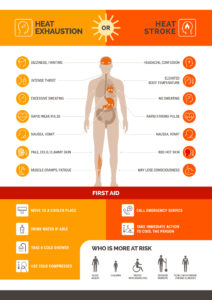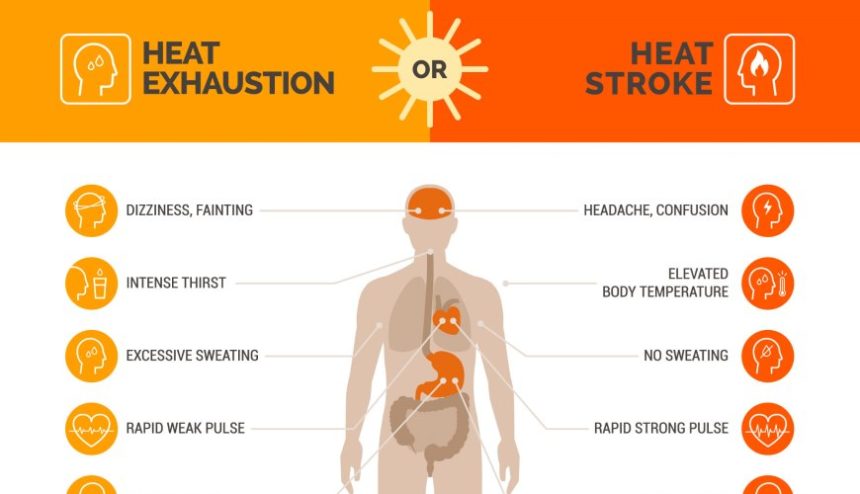 By Thomas Pahl, PA-C, Emergency Department
By Thomas Pahl, PA-C, Emergency Department
With summer here, many of us spend as much time in the sunshine as possible – trying to store as much of it as possible to help us get through the next cold winter. Warmth and sunshine feel great after the long cold winter; however, they should come with a warning label, especially for children under the age of 4 and adults over 65. Spending too much time and being too active in the heat without adequate hydration can quickly lead to heat exhaustion and heat stroke.
What are the symptoms of Heat Exhaustion?
Common heat exhaustion symptoms include muscle cramps, dizziness, fatigue, headache, nausea, pale skin, profuse sweating, and rapid heartbeat. Heat exhaustion should be taken seriously because it can quickly progress to heat stroke. Strategies to help bring down your body’s temperature include immediately getting out of the heat and resting in an air-conditioned room or a cool, shady place outdoors. Your body is dehydrated, so drinking plenty of water or Gatorade is essential. Remove any unnecessary clothing and take a cool shower, bath, or sponge bath applying water to the armpits, groin, neck, and back. Contact a healthcare provider if the heat exhaustion symptoms don’t subside within 30 minutes.
What is Heat Stroke?

Heat stroke occurs when your core temperature rises above 104 degrees, and your body’s regulation system is overwhelmed by excessive heat. Fainting may be the first sign. Other symptoms besides heat exhaustion include a throbbing headache, red, hot and dry skin, lack of sweating, vomiting, rapid and shallow breath, confusion or disorientation, seizures, and unconsciousness. Heat stroke can lead to death if not treated rapidly. If any of these symptoms are experienced, call 911 immediately. Even if you don’t have a thermometer to take your temperature, do not hesitate to initiate body cooling efforts if you experience any of the above symptoms. If there is a delay in getting to the emergency room, contact the hospital for additional instructions. Apply first-aid to help cool the body until paramedics arrive.
Prevention
Environmental conditions, such as high humidity and high temperature with little or no wind, can make it hard to stay cool. Intense physical activity or wearing heavy, restrictive work clothing can also cause the body to overheat because fluids are lost through sweating and aren’t replenished fast enough. Being well-hydrated is essential and includes drinking plenty of water before, during, and after being active. Drinking 8 ounces before being active and drinking moderate amounts of fluid every 15 to 20 minutes during activity should be adequate for most individuals. Light-colored, lightweight, single-layered, absorbent clothing is best because it allows your body’s sweat to evaporate. In addition to children under 4 and adults over 65, some individuals are more susceptible to heat exhaustion and heat stroke. In addition, certain health conditions, such as diabetes, and medications may affect your ability to cope with extreme heat and humidity. Please consult your health care provider if you have questions about how heat may affect you.
After recovering from heat stroke, you’ll be sensitive to high temperatures for at least a week. Your health care provider will advise when it’s safe to resume normal activities. Until that time, avoid hot weather and strenuous exercise.


